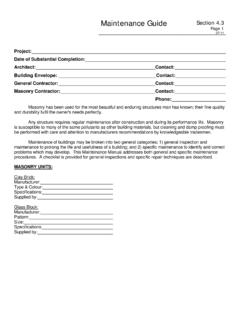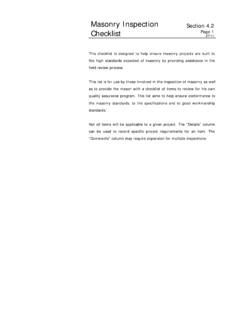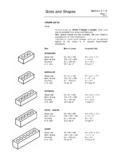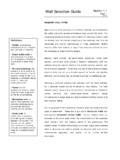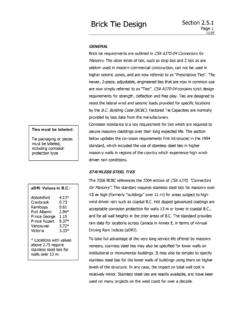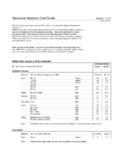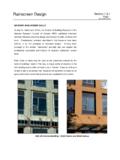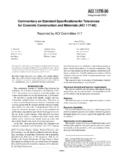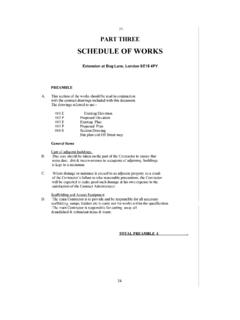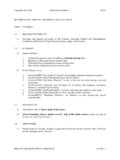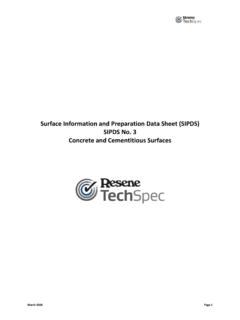Transcription of Masonry Standards Section 3.1 Commentary
1 Masonry Standards Section Commentary Page 1. 06/09. For a detailed discussion of the CSA Masonry Standards see the full MIBC Technical Manual at . The following Standards are reviewed in this Section : CSA concrete Block CSA A82-06 Clay Brick CSA A179-04 Mortar CSA A179-04 Grout CSA A 370-04 Masonry Connectors CSA A371-04 Masonry Construction For information on CSA Design of Masonry Structures see MIBC Tech. Man. Section This update is based upon the 2004 editions of the Masonry Standards referenced by the 2005 National Building Code, and the 2006 Building Code. The clay brick standard was issued in 2006 and must be referenced by project specifications, _____. concrete BLOCK - CSA 04 (MIBC Tech.)
2 Man. Sec. ). Covers: Compressive Strength Not Minor chipping &. Density (Weight) covered: cracks Drying & Curing Texture or Profile Dimensions & Colour Tolerances Fire, Sound or Major Defects Thermal values For a detailed Guide Typical spec - H/15/A/M. Specification see MIBC Technical H = hollow Manual Section 15 = compressive strength 15 MPa standard inventory strength (net area). 20 to 30 available at a small cost premium A = standard (heavy) weight - sand and gravel, 18 kg (40 lbs) /unit Other options are: B & C: semi-light weight - partially pumice D: light weight - mostly pumice - fire block M = moisture controlled - cured, dried Section Masonry Standards Page 2. 06/09 Commentary Sample spec : concrete Masonry units to CSA requirements Classification H/15/A/M.
3 Quality control Test data or Letter of Assurance from supplier if deemed necessary. Job site tests only if specified for critical high strength applications. Fire ratings (See Section in MIBC Tech. Manual). Two Methods: 1. Building Code - applies to block from any supplier - based on equivalent thickness and aggregate type from Table D- in Building Code - typical 20 cm block 1 hrs. - can be increased by filling cores with grout or adding drywall etc. 2. - available from certified suppliers based on tests and plant checks - higher values for same thickness - typical 20 cm ULC block - 2 hrs.; 20 cm pumice - 4 hrs. - small cost premium to cover ULC charge to manufacturer Sound Ratings (STC) (See Section in MIBC Tech.)
4 Manual). - based on wall weight - check with suppliers or MIBC. Thermal values (See Section in MIBC Tech. Manual). - based on R value for block weights, and core fill or external insulation - heavy mass moderates temperature swings to provide superior performance for a given R value compared to lightweight systems. - Check with supplier or MIBC for values Masonry Standards Section Commentary Page 3. 06/09. CLAY BRICK - CSA A82-06 (MIBC Tech. Man. Sec. ). Covers: Compressive Strength Not covered: Fire, Sound Absorption, Durability or Thermal Dimensions and Tolerances values Colour and Texture Sampling Defect Tolerances Typical spec Size, Colour, Texture, Manufacturer(s). Type S standard tolerances; tighter tolerances for project job lots.
5 Grade EG - Exterior Grade always required for our freeze/thaw climate. Reclaimed brick can be damaged by freeze/thaw or may not meet current Standards - confirm suitability before exterior use. New, Grade EG brick are available in textures similar to reclaimed units. Structural clay units also are covered by CSA A82-06. Sample spec : Clay Face Brick [and Structural Brick] to meet CSA A82-06 requirements. Grade EG, Type S. Quality control: Test data or Letter of Assurance from supplier if deemed necessary Fire ratings: (See Section in MIBC Tech. Manual). From Code based on equivalent thickness. Typical face brick - 1 hr. Sound and thermal ratings: (See Section & 3 in MIBC Tech. Manual). Check with supplier or MIBC.
6 Cavity insulation preferred over stud space insulation due to elimination of thermal bridging and protection of membranes. Section Masonry Standards Page 4. 06/09 Commentary MORTAR - CSA A179-04 (MIBC Tech. Man. Sec. ). Covers: Raw Materials Not covered: Mortar for stonework Mortar Types - S & N Colour Mixing Process Installation Proportion or Property Specification Typical spec Two distinct methods for strength: 1. PROPORTION METHOD. - typical for Site-mixed mortar - applies unless Property Method is specified - RECIPE for volumes of sand and cementitious materials from CSA A 179 tables - quality control by inspection of mix proportions at site - not by cube tests 2. PROPERTY METHOD. - typical for Pre-mixed dry or wet mortar - must be specifically specified - cube tests to meet strengths in CSA A179 Table 5 (MPa @ 28.)
7 Days). Job / Plant Mixed Lab Prepared (laying consistency). Type S Type N 5. - job and lab strengths are different due to different water contents. - suppliers of pre-mixed mortar can provide current test results for quality control. Sample spec : Mortar to: CSA A179-04 requirements Type S, mortar for structural Masonry Type S, mortar for veneer Masonry Proportion specification shall apply to field mixed mortar Property specification shall apply to mortar manufactured off-site. Masonry Standards Section Commentary Page 5. 06/09. Mortar type & composition - Mortar types are defined by their relative amounts of sand and cementitious materials. - Bond is a key property of mortar, and is associated with good workability, adhesion, cohesion and water retention - all of which improve with a higher proportion of lime or mortar cement in the mix.
8 - Compressive strength is not the most important property for mortar, although reasonable strength is required for durability. A. balance of strength and bond is, therefore, required for good mortar. Type S'. Typically used for both structural and veneer block and brick. It provides moderately high strength with good bond. Provides simple jobsite mixing where both structural and veneer Masonry units are being installed. Type N'. Once used for veneer brick and block, but now usually replaced by Type S. Types O' and K'. Mortars with high lime contents used for historical restoration. Cement/Lime mortars were historically recommended because their raw materials and resulting properties were well established.
9 The Masonry Cements and Mortar Cements now commonly used are proprietary products, which replace separate cement and lime bags for site mixing. Current versions are now the most commonly used materials to meet Type S mortar strengths, without the addition of Type GU (10) cement. See manufacturers' data for further information. Section Masonry Standards Page 6. 06/09 Commentary GROUT (Block Fill) - CSA A179-04 (MIBC Tech. Man. Sec. ). Covers: Raw Materials Not covered: Grout Type Installation coarse or fine (see A371-04). Property or Proportion spec Slump Typical spec Most Masonry grout (block fill) is Coarse Grout , with a maximum aggregate size of 12 mm. Fine Grout would only be used in small core units such as reinforced brick.
10 Grout is usually supplied and pumped from ready-mix trucks, with quality control data available from the supplier. Field test cylinders may also be taken. Grout strength specification is an area of some confusion. Because grout must flow for substantial distances through small core openings, it must be placed at a very high slump of 200 to 250 mm. This extra water is then absorbed into the units to provide a concrete mix with a lower water content - and higher final strength. Grout tested using standard non-absorptive plastic or metal cylinders will still contain the extra water, and will therefore show lower apparent strength results. The latest CSA A179 recognizes this situation by referencing a MPa grout strength when cylinders are used.
